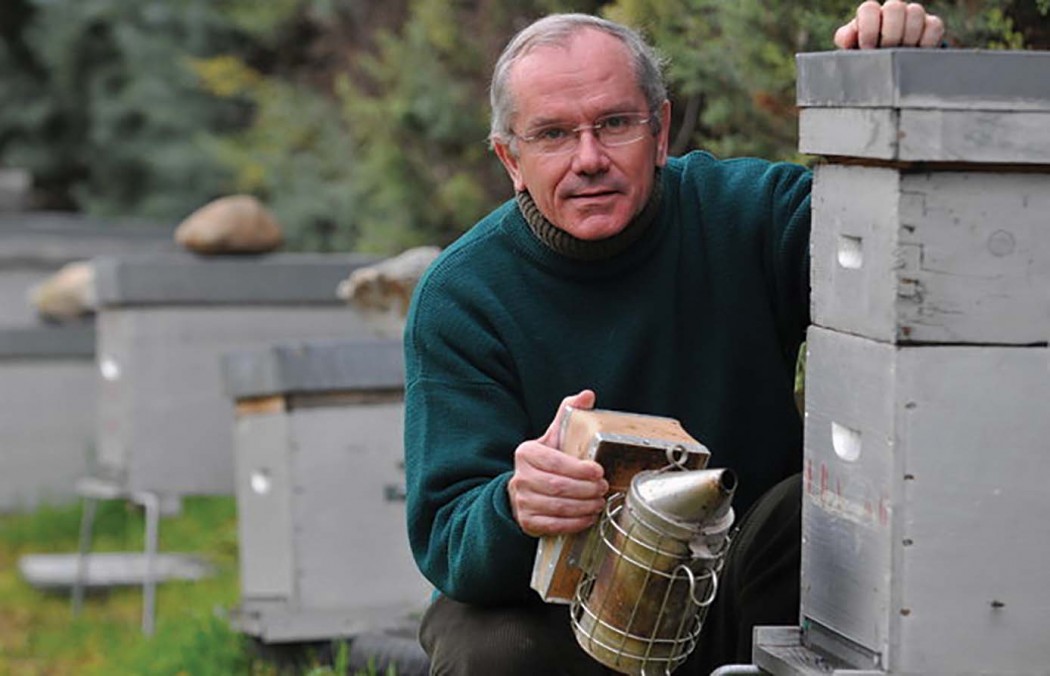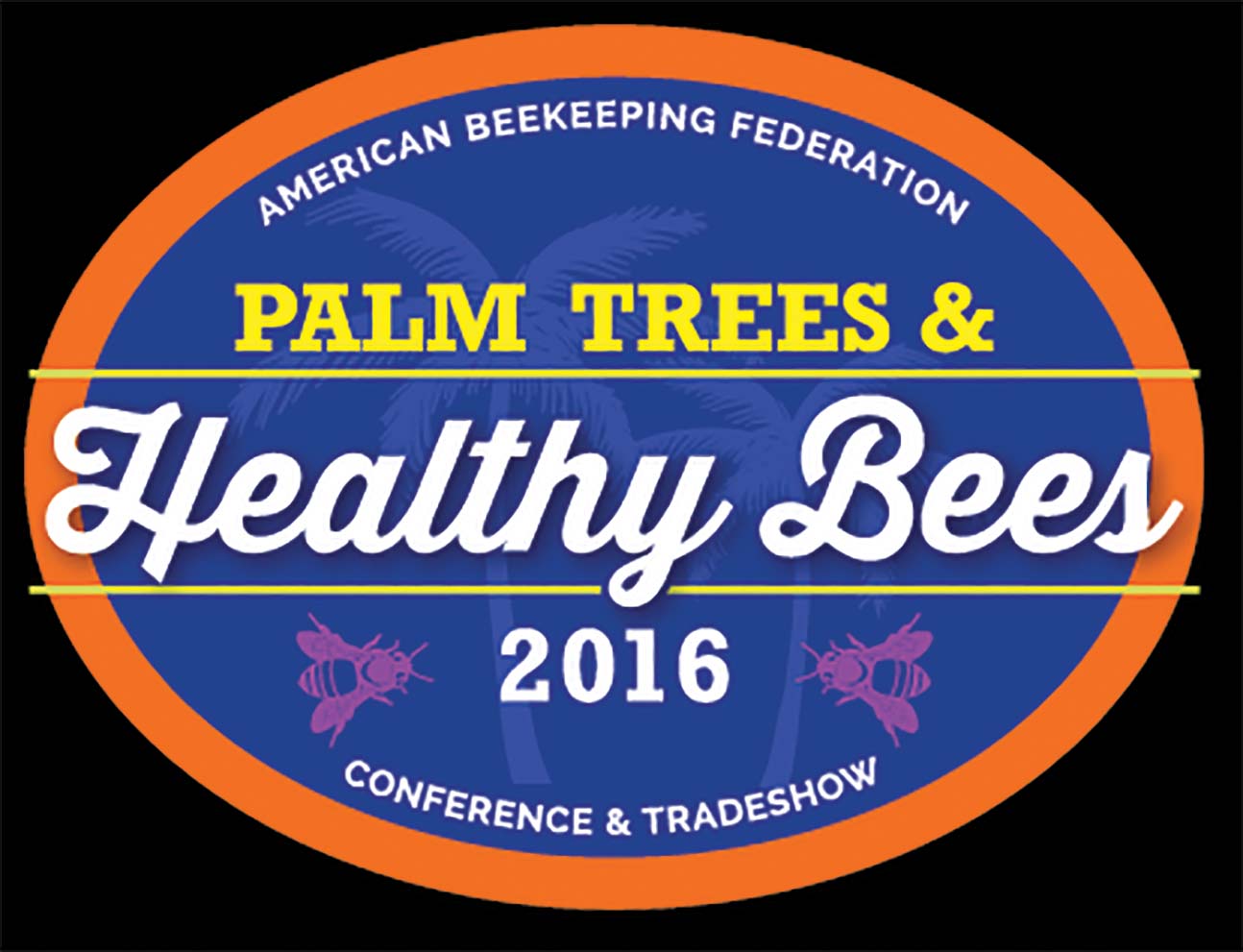by M.E.A. McNeil
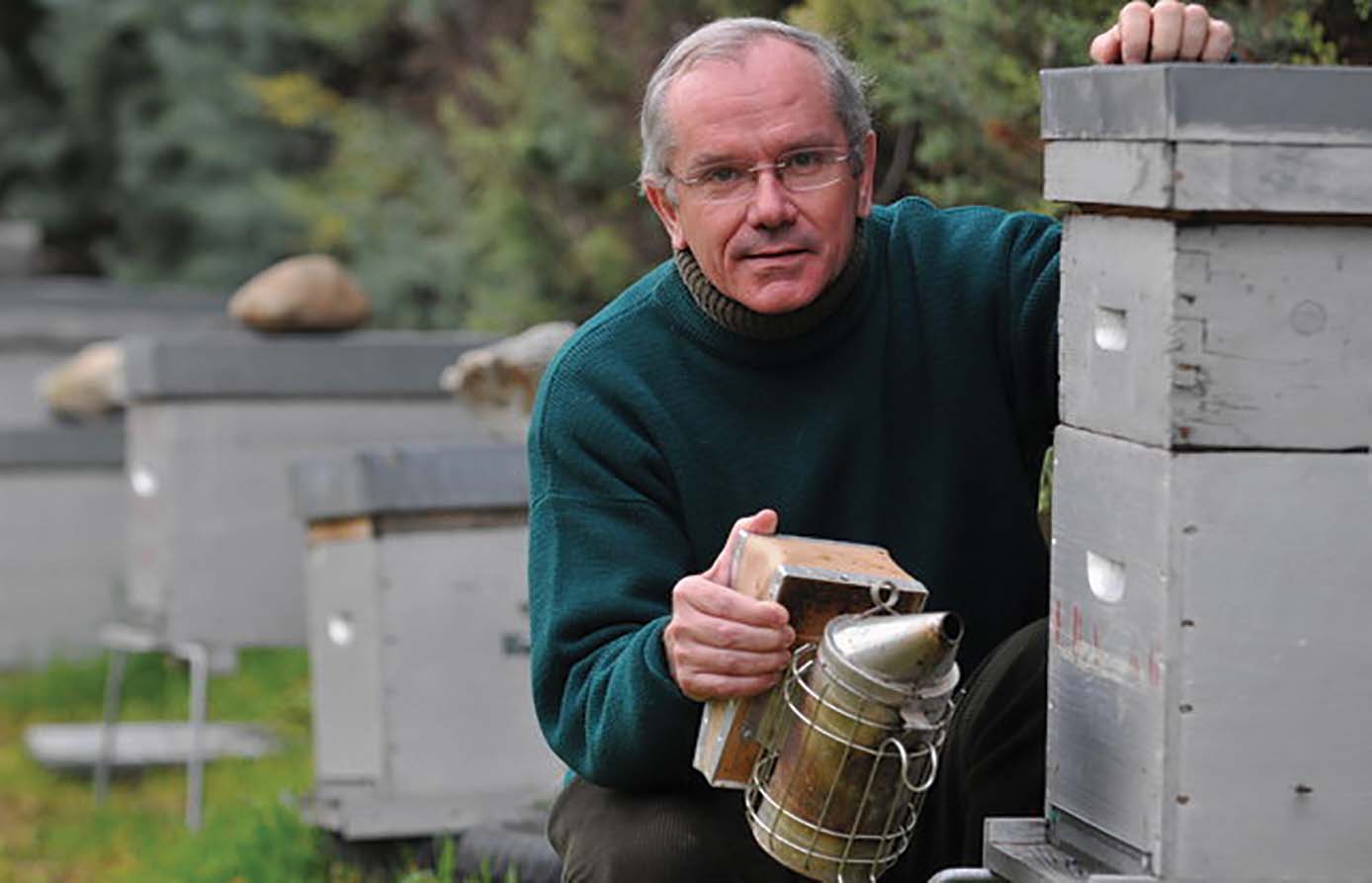
Yves Le Conte, Director of the French National Bee Lab (l’Institut National de la Recherche Agronomique, INRA) at Avignon, is studying an apiary of Varroa-resistant honey bees. (photo by Jérôme Rey)
A boy drew close to a pollen-flecked bee on a flower, watching intently. He is still watching bees, decades later as head of the national bee lab in France. “I was quite alone at the beginning,” said entomologist Yves Le Conte of his childhood fascination. Now he shares that passion with hundreds of collaborators.
His childhood memory is of a profusion of bees on his family farm near Le Mans – the hum, the smell; a multitude of stings did not quell his unrequited determination to train the bees like pets. At age 12, he was far more engrossed with that project than he was with school, so his mother promised him his own swarm as a reward for turning his attention to his books.
When the bees went silent in the 1980s, it was heartbreaking. Varroa had swept through France “like a deadly wave,” he said. “All the feral colonies were dead.” At that time, he was beginning his PhD work at the University of Paris, and he made a prescient choice to focus his inquiry on the mites.
On a visit to the farm in 1993, he was surprised to notice some honey bees in the chestnut trees and chimneys where they once proliferated. Curious about how they were surviving when most bees were not, he created an apiary to better understand them. He added to it by seeking out bees that had withstood the mites from beekeepers that had never treated. “I thought, ‘Maybe there is something there’.” But he didn’t know what.
By 1990, Le Conte had begun work as a researcher at the French national bee lab in Avignon (INRA: Institut National de la Rocherche Agronomique/Abeilles et Environnement). Because the apiary at the farm near Le Mans was a full day’s drive away, the bees there were untended. Yet they continued to survive for years while losses from mites continued to plague French apiaries. When he mentioned this phenomenon to a commercial bee group, they offered funding for him to study the bees, which he supplemented with government grants.
He made a decision early on to work collaboratively. He’d spent years during his doctoral studies cringing from a competitive atmosphere; he found himself more suited to open cooperation with his peers. “I should not be naïve because science is competitive,” he said. “But I didn’t want to make my life competitive, and I wanted to work with the best scientists. I discovered that collaboration was much more enthusiastic and efficient.” So he drew other researchers into his work, and he joined theirs – several hundred by now. And together they have been able to enhance the understanding of bee metabolism, behavior, chemical communication, and reproduction. Le Conte made pheromones his area of specialty. That was another prescient choice, since interactions between the mite and its bee host is influenced by many signals, but chemical communication appears to be the most important (Nazzi & Le Conte 2015).
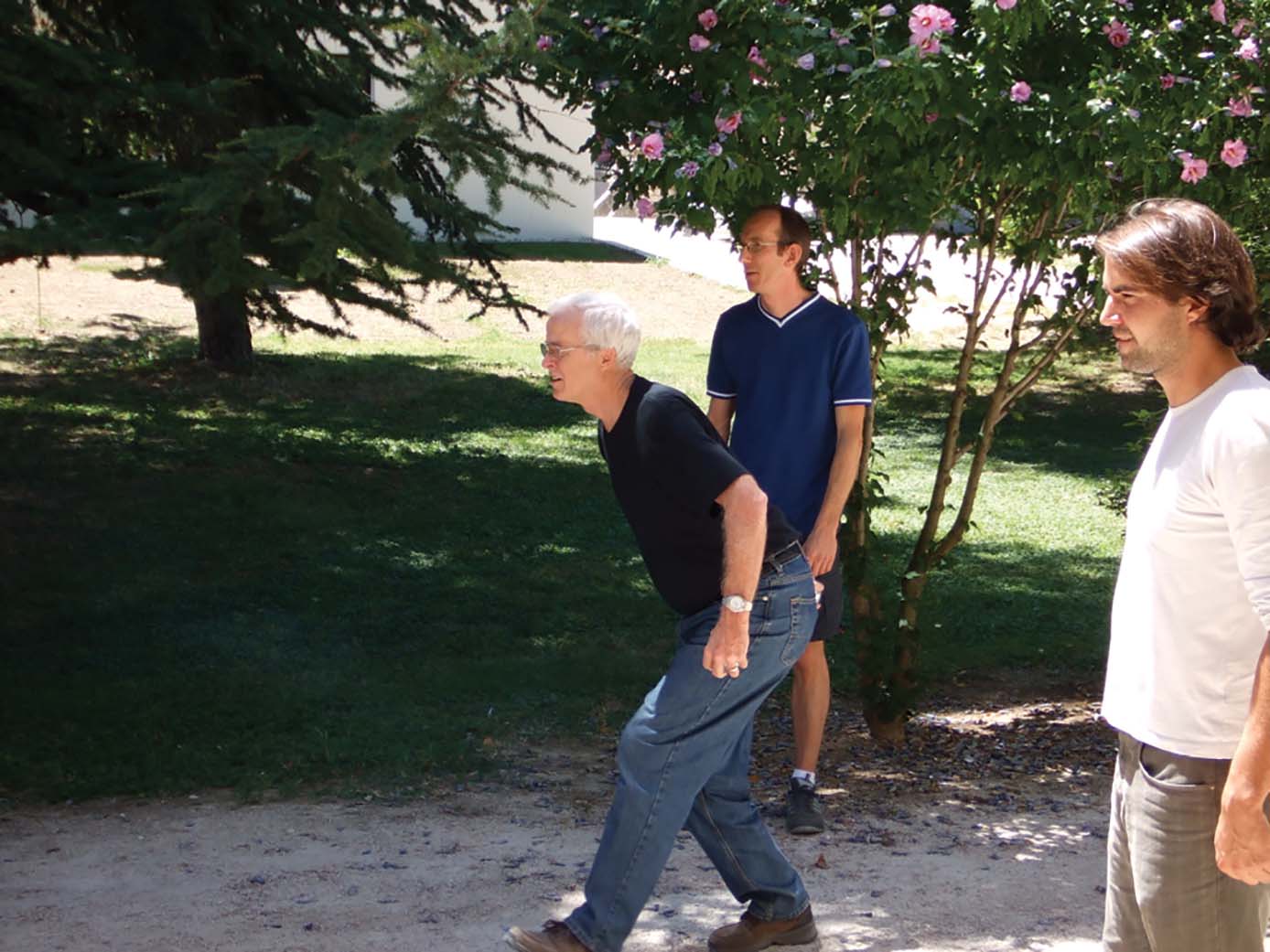
Follow that swarm! Marion Ellis of the University of Nebraska did research during his sabbatical at Le Conte’s lab in Avignon, France. He said, “I’ve never worked in a lab with such a great esprit de corps.” (photo courtesy Yves Le Conte)
He and his colleagues are searching on the edge of what is known. Now, as head of the lab, he is in charge of a broad array of programs dealing with behavior, physiology, genetics and pathology of the honey bee. Some discoveries fit into the puzzle of the survivor bees, and others are simply reeled in over that edge to add to broader understanding of bee biology.
“I worked with some 70 colonies that were not treated,” he said, “Some of which survived for seven or eight years. The question was: Why? We still don’t have all the answers, but we have uncovered many of the characteristics that help these bees survive Varroa.” They knew that Apis mellifera, Varroa destructor and mite-vectored viruses form a complex system of interactions.
When he started, Le Conte was aware that the idea that bees could have resistant traits to pathogens was not new, but it was not always known that the behaviors could relate to pests; a history of inquiries gave him some clues. In the 1930s, American researchers Park and Pendell observed protective traits against disease. In 1942, Woodrow and Holst reported observing bees uncapping and ridding the hive of larvae with American foulbrood in the latent, noninfectious state – with the spore-carrying adult bees not infected. Rothenbuhler at Ohio State picked up the research in the 1950s, coining the term “hygienic behavior”. He knew that it did not sort out cleanly as a Mendelian trait, but he did not have the technology to show its complex control by a suite of genes. At that time, the research was abandoned, as chemical solutions became favored over the complexity of breeding.
It was not until the 1980s that Steve Taber re-examined the behavior, and he and Martha Gilliam at the USDA in Tucson found that it produced resistance to chalkbrood as well as foulbrood. How that might apply to the devastating mites was only speculation. They encouraged Marla Spivak to take the quest from that lab to her new post at the University of Minnesota in 1993, and there she eventually developed the resistant Minnesota Hygienic line of bees.
Meanwhile, to go back to the Continent, American entomologist John Kefuss had started a commercial apiary near Toulouse, France. He was supplying bees 1983-91 to labs testing chemical treatments for mites such as amitraz and Apistan. Kefuss was at an impasse: He’d concluded that the chemicals were harmful to bees, but his doctoral mentor Friedrich Ruttner maintained that bees could not be bred against mites “any more than sheep could be bred against wolves”. It was in Tunisia, on a project with entomologist Wolfgang Ritter, that Kefuss observed resistant bees in apiaries of farmers too poor to treat their hives. Both he and Ritter tested the Tunisian bees, and it appeared that the characteristic was genetic. About the same time, 1993, Danny Weaver in the U.S. was also experimenting with resistant breeding. “By 1996, we knew we could select for Varroa resistance,” said Kefuss. Ruttner graciously conceded.
Kefuss, a bee breeder, said, “It’s not important to know just why a particular strain is surviving.” He explained that getting to a destination in a plane does not require an understanding of the mechanisms. To that end, he has distributed resistant queens to his neighbors to keep up open mated stock. He invites all comers to find mites in his apiary, for which he pays one Euro cent per mite – with few payoffs.
Le Conte and his colleagues are on a different mission: For them, it is very important to know why a strain of bees is surviving; they want to understand the mechanisms. That is the point. To do that, they are willing to examine the biology to a molecular level.
Working collaboratively with other researchers “is a very positive experience for me. We grow together, we publish together”. He has teamed up with the same two technicians at his lab for 20 years, and he has ongoing relationships with many of his international collaborators. “They send me students, PhDs, postdocs and everyone has added a stone to the building.”
He has had a special connection to American researchers, as his wife’s father was an American Army engineer: Among them are Gene Robinson of the University of Illinois, Marion Ellis of the University of Nebraska, Mark Winston and Keith Slessor of Simon Frazier University, Danielle Downy now of Project Apis m – and many others, including Greg Hunt, Gloria Degrandi-Hoffman, Robert Page, Amy Toth, Kristin Traynor, Marsha Wheeler, Ernesto Guzman-Novoa and Gard Otis.
It was speculation on the relationship between bees and the mites that led Le Conte to investigate pheromones – the olfactory messaging system in a colony. He worked on the discovery that he calls his “lucky” find: a brood pheromone, a complex blend of fatty acid esters exuded by the larval salivary glands, which are the source of both primer (long term effecting) and releaser (short term effecting) pheromones (Le Conte 2006). With Gene Robinson at the University of Illinois and others, he spent more than eight years toward a discovery of a forager pheromone that inhibits nurse bees’ behavioral development. It insures the equilibrium between nurses and foragers in the colony. Then the team found a highly volatile brood pheromone involved in social regulation, E-β-ocimene. With it, young larvae express their nutritional needs to workers with a signal to optimize food collection. Le Conte established that it is a primer pheromone. (Note: bees are the only social insect for which any primer pheromones have been identified.) He and his colleagues found that E-β-ocimene has two effects on worker physiology: inhibition of worker ovaries and acceleration of the age of the onset of foraging for workers (Maisonnasse 2010).
E-β-ocimene is produced by newly hatched to three-day old larvae, whereas the previously identified brood ester pheromone, a contact pheromone effecting nurses, is produced primarily by old larvae – four and five days old. “So one compound gives an opposite message to the other,” said Le Conte. “Interesting, very interesting. The signal from the very young larvae is for bees to forage because they are in need of food. When they are older, they have their food, they’re good to go and they can release the foragers.”
The significance of these pheromones to Varroa is that they act as kairomones (substances produced by one species used to the benefit of another). In sum, the mites tune in to the bees’ communication system to guide their parasitism. Handy for Varroa, brood pheromone increases up to 20 times during capping, when mites need to sense that it is time to enter the cell.
“That was my first work,” said Le Conte, “And I have worked on it ever since.”
Le Conte spent his sabbatical year in the U.S. at Gene Robinson’s lab at the University of Illinois. He said, “Gene was the first to use more sophisticated analytical tools,” which allowed their team to make an important discovery.
Robinson writes, “We became close colleagues and friends for over 25 years and counting. One of the high points of my career was my laboratory’s collaboration with Yves and members of his laboratory to find the worker inhibitory pheromone, a pheromone that is produced by older adult worker bees and inhibits the behavioral maturation of younger workers . . . Finding it proved to be elusive. Teaming up with Yves’ lab we did indeed find it – and it has been a lynchpin in our understanding of how division of labor is regulated in the honey bee society.”
That substance, ethyl oleate (EO), is so far the only primer pheromone identified in workers that is involved in foraging behavior. It is synthesized de novo by adult forager honey bees (Leoncini et al 2004). It is nearly absent in young bees, although it is perceived by them through olfaction, and acts to delay the onset of foraging. It is most abundant on the worker cuticle and transmitted at close range – picked up by olfactory receptors on antennae, processed in the antennal lobe, and learned in olfactory centers of the brain (Muenz et al 2012).
What is the function of this inhibitory pheromonal message, opposite to the brood pheromone E-β-ocimene that signals the onset of foraging? One known fact is that EO is produced by foragers when exposed to ethanol from fermented nectar. Experiments with live bees fed ethanol demonstrated that EO is produced, accumulating in the honey crop and exuding to the exoskeleton. It exerts a primer effect on young bees to delay foraging and stay home (Castillo et al, 2012). Honey would ferment without enough in-house processors.
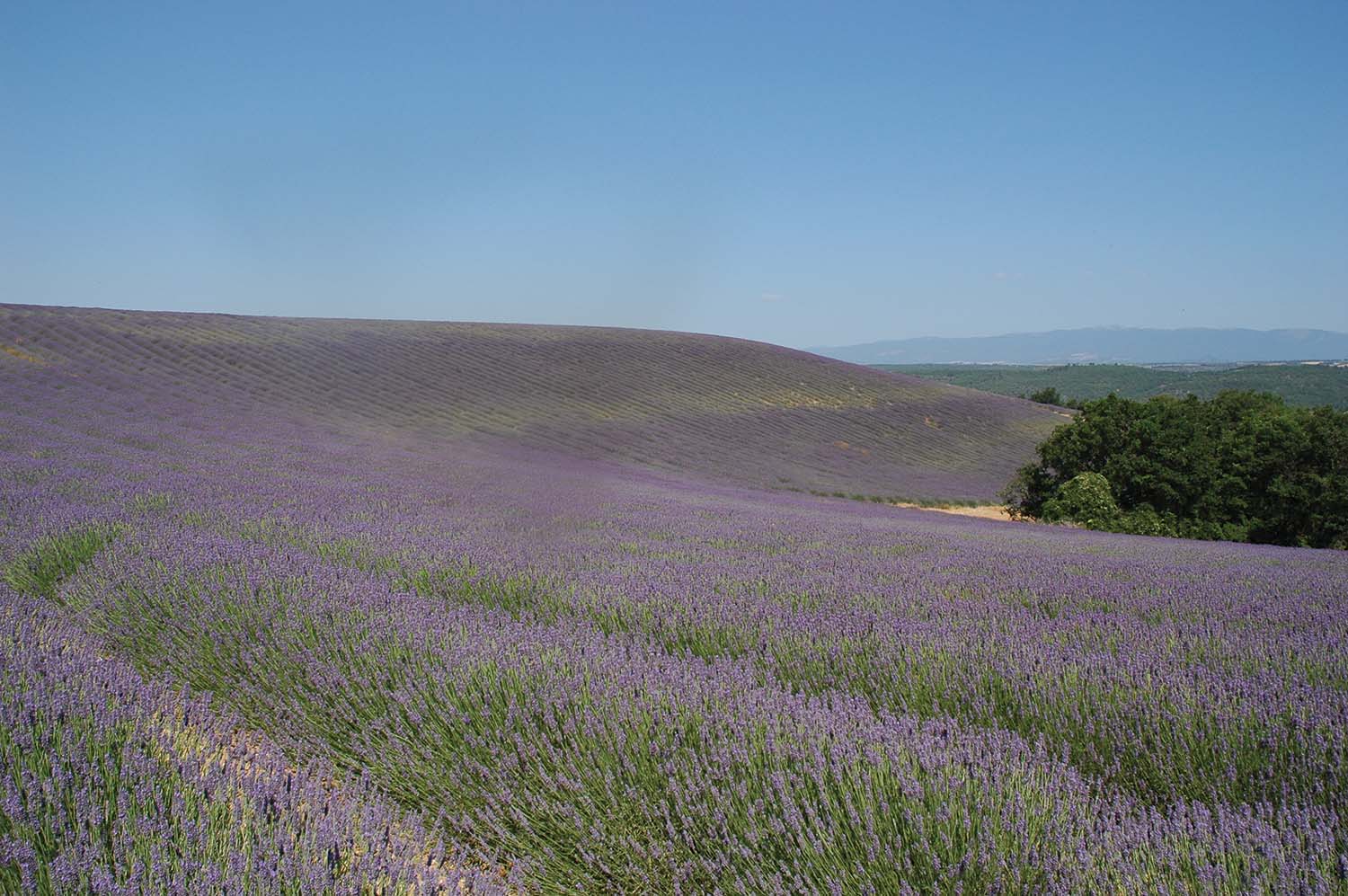
Lavender fields surrounding the National Bee Lab at Avignon, France. (Photo by Marion Ellis)
An interesting twist is the relationship of EO to bees infected with Nosema ceranae (microsporidian parasites). It has been found that Nosema infection reduces homing and orientation skills and alters metabolism of foragers. N. ceranae-infected bees also show increased EO levels, which delay the maturation of same-age healthy bees. It has been suggested that it is a protective response, extending the lifetimes of healthy bees inside the hive (Dussaubat et al 2013).
The role of identified pheromones was explored by Le Conte with Mark Winston and Keith Slessor of Simon Frazier University – their complexity, synergy, context, and dosage over space and time. Their work demonstrated that these specialized chemical signals provide a syntax that is deeper in complexity and richer in nuance than previously thought. (Slessor et al 2005). Le Conte pointed up over his desk to a fishing photo of Slessor, who died in 2012, he said, “Here he is. We were good friends.”
He keeps a friendship with Winston, who wrote that “We worked together on a number of projects involving honey bee pheromones – Yves is a delight to work with. It was quite a thrill!”
Work with Danish stock at the INRA lab revealed that Nosema-resistant bees tolerate a higher N. ceranae spore load, an up-regulated immune response, and lower mortality (Huang et al 2012). A recently discovered trait of N. ceranae is an ability to manipulate apoptosis (healthy, programmed cell death) in hosts to improve their invasion. However, the Nosema-tolerant stock has been found to escape that mechanism (Kurze et al 2015).
But the Nosema-tolerant bees are not the same as the Varroa-tolerant bees. The stock resistant to Nosema came from Denmark, where beekeepers had selected against Nosema for a long time. The 2011-12 onslaught of Nosema ceranae in the Varroa-resistant Avignon apiary brought heavy losses, “But 20% of the remaining bees were very, very good, and we grafted from them, and they have done well.” The Avignon apiary is open-mated in an area of other apiaries and the Le Mans apiary, which continued to thrive, is more isolated.
Le Conte has also collaborated with John Harbo at the USDA Baton Rouge lab on an analysis of the brains of VSH (Varroa Sensitive Hygiene) bees to identify genes involved with that expression. VSH is a trait discovered and developed by a team at that lab. Bees with the trait have ability to sense and rid the colony of pests and pathogens. Selection for VSH has resulted in not only resistance to Varroa mites, but also to American foulbrood and chalkbrood, as well as, reportedly, defense against wax moths and small hive beetles. The trait involves a small group of genes, VSH alleles (alternate forms of genes).
However, Varroa tolerance is a complex phenomenon involving many genes associated with metabolism, behavior, chemical communication, reproduction. Using gene expression as a tool, the French lab studies the molecular basis of host-parasite interactions.
In investigating the mechanisms of VSH behavior, Le Conte’s young colleague Fanny Mondet concluded that antennae play a key role. Enhanced detection of some odorants as well as higher metabolism and antennal motor activity were found in bees with VSH behavior (Mondet 2015). This work brings attention to the role played by the bees’ peripheral nervous system, adding criteria for promoting genetic-marker-assisted selection for Varroa-resistant bees.
The lab studied two “natural” survivor honey bee populations in cooperation with the I. Free lab in Sweden. Colonies in Avignon and Gotland, Sweden were compared with Varroa-sensitive colonies. They found more reproduction of mites in sensitive colonies. The survivor stock had coevolved resistant traits that reduce the reproductive success of the mite by about 30% in both places. But, interestingly, under similar selection pressures of mite infestation, the two geographically and genetically distinct populations have evolved different mechanisms of resistance: The Avignon population had high levels of mite infertility, while in Gotland there was a higher proportion of mites that delayed initiation of egg-laying (Locke et al 2012). “We saw that gene expression favors Varroa multiplication, said Le Conte. “Genes are expressed up and down in the pupae, and expressed differently in parasitized pupae,”.
Adaptation appears to be a local occurrence. Even with accumulated understanding of resistant traits, it appears that the bee showing excellent performance and superior pest and pathogen tolerance across all environments does not exist. An 11-nation project, “The Pan-European Genotype-Environment Interactions Experiment”, was conducted by the Research Network for Sustainable Bee Breeding, a working group within the international research consortium COLOSS (prevention of COlony LOSSes). Local bees and non-local bees were compared within the five sub species of Apis mellifera (A.m. mellifera, carnica, ligustica, macedonica, siciliana). The local strains consisted of breeding lines maintained at the institutes involved and other regional stock. The local strains were compared to at least two non-local strains over 2½ years. Survival time differed noticeably, with the local strains surviving longer – the French lab’s longest. “It seems logical to me,” said Le Conte, “Because if you put one ecotype of a bee that is well adapted to a biotope and you take it to a different biotope, the bees may not be able to adjust to both the environment and the mites.”
In addition, that project demonstrated that viruses exhibit substantial genetic variation across regions. It was suggested that local bees may be better adapted to “their” strains of viruses.
In the COLOSS study, the local bees were more gentle and better honey producers. The Avignon resistant bees build up naturally too late to pollinate orchard crops, however. Beyond their significant role in research, Le Conte said, “We need feral colonies to pollinate in nature, so they can perform an important function there” – since the honey bee is native to Europe.
Among other observations on the French resistant, naturally selected bees is that their propolis contains more caffeate. Le Conte said, “We have not understood whether it is environmental (the resin is simply available) or behavioral (that the bees shop selectively for the most advantageous medication).”
Le Conte said, “When we look at gene expression of the resistant bees compared to sensitive bees parasitized by the mites, the gene expression is in the pupae. There is up and down regulation of genes as a result of the parasitism. We found 99 genes activated or deactivated – differently expressed. It is not a question of resistant or not resistant, but a question of what the mite is doing on the pupae.”
Other genetic effects of Varroa infestation have been found in the gene expressions of the nutritive effects of pollen (a field called nutrigenomics). Pollen activates nutrient-sensing and metabolic pathways as well as genes affecting longevity and the production of some antimicrobial peptides. But Varroa infestation and the concurring viral infections inhibit protein metabolism, and the effect was not reversed by pollen uptake (Alaux et al 2011).
As the French lab explored the characteristics of their survivor stock, some conclusions were reached: The Varroa population the bees are exposed to is genetically not reduced in virulence. Significant differences in viral loads were found between surviving and control colonies: Controls had more APV (Acute Paralysis Virus) and CPV (Chronic Paralysis Virus), (but when injected with virus there was no significant difference for APV or CPV, so it appears that resistance occurs before invasion). Behavioral responses demonstrate the better capacity of the surviving bees to recognize the mite. Hygienic behavior was not greater in resistant bees than sensitive ones; the resistant stock shows VHS behavior.
What now? Le Conte and his colleagues posit that coevolution by natural selection has been hindered by apicultural practices that remove the mite, and consequently remove selective pressures. Marla Spivak of the University of Minnesota calls it a co-evolutionary arms race with pathogens serving as selective pressures, allowing for survival traits to emerge. But Spivak, like Le Conte, asks people to take the pattern, not the product. They offer insight, not beehives.
“I think that the scientific community is now convinced that selecting for resistance is possible – which is very exciting to me,” said Le Conte. “The idea is to find tools. They can be genetic markers, they can be physiological markers, pheromones or kairomones. And these tools could tell you whether to select a colony as a breeder.”
There is a lot to be said for this international band of collaborators as contributors to this quest. Robinson said that Le Conte has “significantly advanced the field of bee biology.” Winston said that the INRA lab is “certainly one of the top honey bee research groups in the world, perhaps the best in Europe in combining basic and applied research. Yves has a wonderful sensibility recognizing the importance of bees for the environment, and seamlessly crosses the boundary between research and the beekeeping community.”
Ellis, who spent a sabbatical at the lab, said of Le Conte, “I’ve never worked in a lab with such a great esprit de corps. Every day when we went to work, he greeted each person personally and would reply to inquiries as to how he was doing: ‘Impeccable’. Nobody I’ve ever met can create that environment like Yves – supportive and holding to a very high standard. His strong suit is that he is wonderful at collaborating and giving others credit. He’s gotten to the top of this field not by stepping on others but by bringing as many people with him as possible. He is the master of collaborative work; it is the only way to handle a lot of complex problems”
Traynor also celebrated working with the “close-knit team.” Downy recalls the camaraderie of a daily stroll with the lab group through the orchard to lunch: “It sounds simple, but the differences that stick most in my mind are the lifestyle and cultural ones. Yves is generous and cheerful – an ambassador of bees, of joie de vivre, of family life and of course science!”
Le Conte is not ready to announce the coup de grâce to Varroa, or to Nosema either. “The bees themselves found the solutions. To me it was natural selection. We have some explanations, but we don’t have all of them. We are really interested to see more of what happens.”
His hope is that Varroa will go the way of tracheal mite as just a beekeeping nightmare from the past. “I am not the only lab working on this,” he said. “There are many. All together we can do this.”
Yves Le Conte will speak at The Marin Beekeepers on Thursday, May 5, 2016 (http://marinbeekeepers.org/) and at The Bee Health Symposium at UC Davis, Mondavi Honey and Pollination Center, on Saturday, May 7 (http://honey.ucdavis.edu/).
M.E.A. McNeil is a journalist and Master Beekeeper living on a small organic farm in Northern California. She can be reached at mea@onthefarm.com.
REFERENCES
Alaux, Cédric, Christelle Dantec, Hughes Parrinello, Yves Le Conte, Nutrigenomics in honey bees: digital gene expression analysis of pollen’s nutritive effects on healthy and Varroa-parasitized bees, BMC Genomics 2011 10;12:496. Epub 2011 Oct 10.
Castillo, Carlos, Hao Chen, Carolyn Graves, Alban Maisonnasse, Yves Le Conte, Erika Plettner, Biosynthesis of ethyl oleate, a primer pheromone, in the honey bee (Apis mellifera L.), Insect Biochem Mol Biol 2012 Jun 3;42(6):404-16.
Costa C., R Büchler, S Berg, M Bienkowska, M Bouga, D Bubalo, L Charistos, Y Le Conte, M Drazic, W Dyrba, J Fillipi, F Hatjina, E Ivanova, N Kezic, H Kiprjanovska, M Kokinis, S Korpela, P Kryger, M Lodesani, M Meixner, B Panasiuk, H Pechhacker, P Petrov, E Oliveri, L Ruottinen, A Uzunov, G Vaccari , J Wilde, 2012, A Europe-wide experiment for assessing the impact of genotype-environment interactions on the vitality of honey bee colonies. J. Apic. Sci. 56:147-158.
Dussaubat, Claudia, Alban Maisonnasse, Didier Crauser, Dominique Beslay, Guy Costagliola, Samuel Soubeyrand, André Kretzchmar, Yves Le Conte, Flight behavior and pheromone changes associated to Nosema ceranae infection of honey bee workers (Apis mellifera) in field conditions, J Invertebr Pathol 2013 May 23;113(1):42-51.
Huang, Qiang, Per Kryger, Yves Le Conte, Robin F A Moritz, Survival and immune response of drones of a Nosemosis tolerant honey bee strain towards N. ceranae infections, J Invertebr Pathol 2012 Mar 20;109(3):297-302.
Kurze, Christoph, Yves Le Conte, Claudia Dussaubat, Silvio Erler, Per Kryger, Oleg Lewkowski, Thomas Müller, Miriam Widder, Robin F A Moritz, Nosema Tolerant Honeybees (Apis mellifera) Escape Parasitic Manipulation of Apoptosis, PLoS One 2015 7;10(10):e0140174.
Le Conte, Yves, Jean-Marc Bécard, Guy Costagliola, Gérard de Vaublanc, Mohamed El Maâtaoui, Didier Crauser, Erika Plettner, Keith N Slessor, Larval salivary glands are a source of primer and releaser pheromone in the honey bee (Apis mellifera L.), Naturwissenschaften May, 2006 16;93(5):237-41.
Leoncini, Isabelle, Yves Le Conte, Guy Costagliola, Erika Plettner, Amy L Toth, Mianwei Wang, Zachary Huang, Jean-Marc Bécard, Didier Crauser, Keith N Slessor, Gene E Robinson, Regulation of behavioral maturation by a primer pheromone produced by adult worker honey bees. Proc Natl Acad Sci U S A 2004 Dec 30;101(50):17559-64.
Locke, Barbara, Yves Le Conte, Didier Crauser, Ingemar Fries, Host adaptations reduce the reproductive success of Varroa destructor in two distinct European honey bee populations, Ecol Evol 2012 Jun;2(6):1144-50.
Maisonnasse, Albon, Jean-Christophe Lenoir, Dominique Beslay, Didier Crauser, Yves Le Conte, E-β-ocimene, a volatile brood pheromone involved in social regulation in the honey bee colony (Apis mellifera), PLoS One 2010 21;5(10):e13531.
McNeil, M.E.A., “John Kefuss: Keeping Bees That Keep Themselves”, The American Bee Journal, January 2010.
Mondet, Fanny, Cédric Alaux, Dany Severac, Marine Rohmer, Alison R Mercer, Yves Le Conte, Antennae hold a key to Varroa-sensitive hygiene behaviour in honey bees, Sci Rep 2015 22;5:10454.
Muenz, Thomas S, Alban Maisonnasse, Erika Plettner, Yves Le Conte, Wolfgang Rössler, Sensory reception of the primer pheromone ethyl oleate, Naturwissenschaften 2012 May 18;99(5):421-5.
Nazzi, Francesco, Yves Le Conte, Ecology of Varroa destructor, the Major Ectoparasite of the Western Honey Bee, Apis mellifera, Annu Rev Entomol 2015 Dec 14.
Slessor, Keith N, Mark L Winston, Yves Le Conte, Pheromone communication in the honeybee (Apis mellifera L.), J Chem Ecol 2005 Nov 25;31(11):2731-45.







